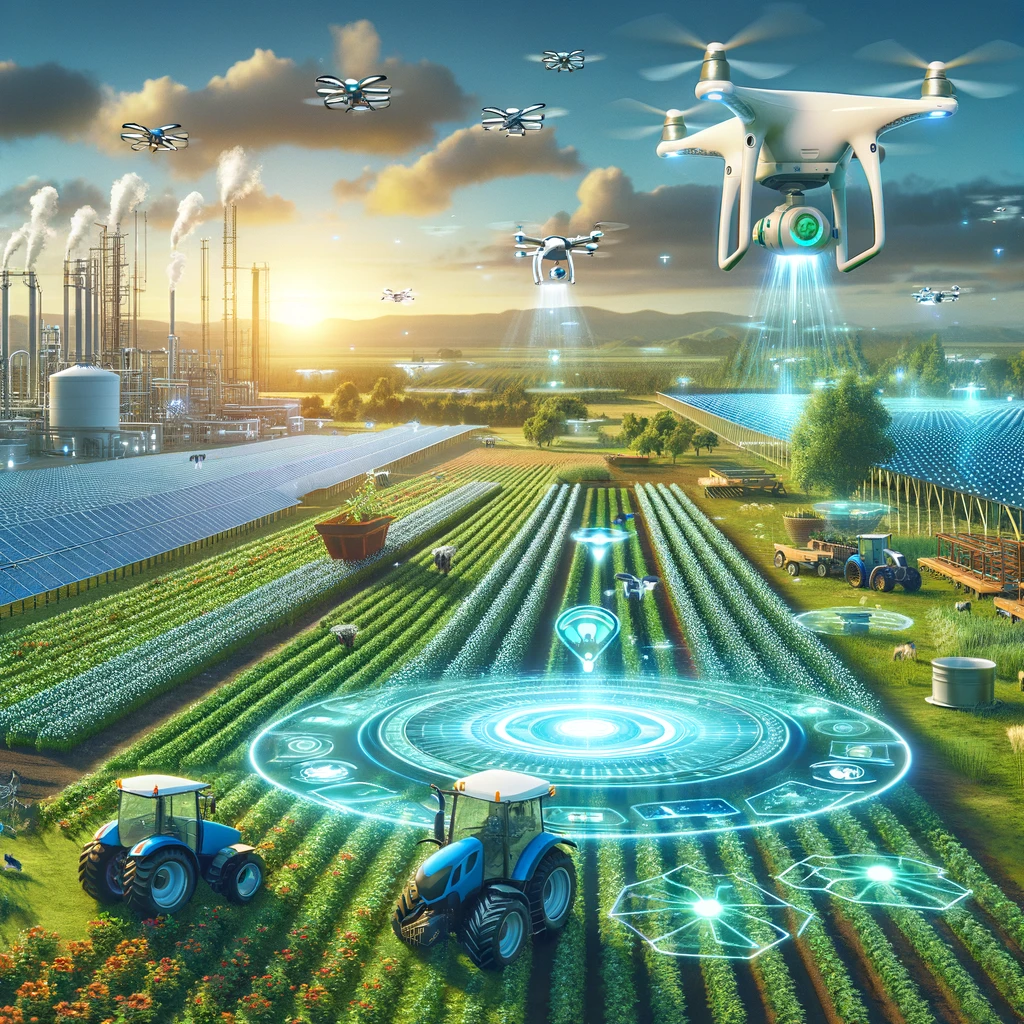In the ever-evolving world of agriculture, technology has always played a pivotal role.
From the earliest plows to modern irrigation systems, technological innovation has been the backbone of agricultural advancement. Today, we are witnessing an unprecedented transformation with the advent of Artificial Intelligence (AI) in the field.
This article delves into how AI is revolutionizing agriculture, leveraging Big Data analytics to optimize production and reduce costs, heralding a new era of efficiency and sustainability.
navegue pelo conteúdo

The Rise of Artificial Intelligence in Agriculture
The journey of agricultural technology to the embrace of AI is a fascinating tale of innovation and adaptation. Traditionally, farmers relied on empirical methods and knowledge passed down through generations to make decisions.
However, with the advent of AI, these methods are being complemented — and, in some cases, replaced — by predictive analytics and smart automation.
The introduction of AI in agriculture has opened doors to a new way of managing crops and livestock. Big Data analytics tools, monitoring drones, harvesting robots, and smart irrigation systems are transforming the agricultural landscape.
AI not only makes production more efficient but also aids in the sustainable management of natural resources, a crucial step towards the agriculture of the future.
Understanding Big Data Analysis in Agriculture
The digital age has brought an unimaginable volume of data. In agriculture, when this data is analyzed correctly, it can reveal patterns, trends, and valuable insights.
Big Data analysis refers to the process of examining large data sets to uncover hidden information that can aid in making more informed decisions.
In this context, agriculture benefits immensely. Data collected from satellites, field sensors, drones, and even weather forecasts contribute to a deeper understanding of cultivation conditions.
This information allows farmers to optimize their agricultural practices, from sowing to harvest, including pest control and irrigation. For instance, soil and weather data analysis can indicate the optimal time to plant, while drone image analysis can help identify areas in need of specific treatment.
Moreover, yield prediction based on historical and current data helps farmers better plan their sales and market operations. This optimization not only enhances efficiency and productivity but also reduces waste and costs, promoting more sustainable agriculture.
AI in Prediction and Optimization of Agricultural Production
Artificial intelligence lies at the heart of the digital transformation in agriculture, offering innovative solutions that go beyond traditional data analysis.
One of the most impactful applications of AI is in the prediction and optimization of agricultural production. Using advanced machine learning algorithms and neural networks, AI can accurately predict crop yields, anticipate potential problems, and suggest corrective measures before they are visibly needed.
By analyzing historical and real-time data, AI can identify patterns and variables that influence plant health and crop productivity.
This predictive capability allows for proactive adjustments in cultivation methods, such as changing the amount of irrigation water, adjusting fertilizer application, or implementing integrated pest management techniques. S
uch adjustments are crucial for maximizing resource efficiency and minimizing environmental impact.
Furthermore, AI also plays a vital role in optimizing the agricultural supply chain. By analyzing market data, demand forecasts, and transport logistics, AI systems can help farmers make informed decisions about when and where to sell their products to maximize profits and reduce post-harvest losses.
These technologies not only enhance the sustainability and profitability of modern agriculture but also ensure resilience against climate change and the growing demands of an expanding global population.
Cost Reduction and Sustainability through AI
The implementation of artificial intelligence in agriculture extends beyond just optimizing production and predicting yields. One of its most significant contributions is its ability to reduce operational costs while promoting sustainable practices.
AI facilitates precision agriculture, where every action is calibrated to the exact needs of plants and soil, minimizing the wastage of resources such as water and fertilizers.
Moreover, AI-powered systems can efficiently manage the application of pesticides, reducing the necessary amount and, consequently, the environmental impact.
This type of management not only significantly cuts costs but also protects the biodiversity surrounding agricultural areas.
Sustainability is another crucial aspect benefited by AI in agriculture. Through the optimization of resource use and waste reduction, AI contributes to creating greener agricultural systems.
This includes water conservation, the reduction of greenhouse gas emissions, and the preservation of soil quality. By aligning agricultural practices with the principles of sustainability, AI helps ensure that future generations inherit a healthy planet and sufficient resources for food production.
Challenges and Future Opportunities
While artificial intelligence offers transformative possibilities for agriculture, the implementation of this technology is not without challenges. One of the main hurdles is the need for advanced technological infrastructure and access to reliable data.
Many agricultural regions still face connectivity limitations and a lack of modern equipment, which can hinder the adoption of AI.
Furthermore, the complexity of AI and the need for specific skills for its management and interpretation represent a significant barrier.
Training farmers and technicians in AI technologies is essential to overcome this barrier and maximize the potential of artificial intelligence in agriculture.
However, the future opportunities are vast and promising. The continual evolution of AI, along with the development of more accessible and user-friendly solutions, has the potential to democratize advanced agricultural technology.
This could lead to a broader adoption of AI across different scales of agricultural production, from small family farms to large agricultural corporations.
The integration of AI with other emerging technologies, such as the Internet of Things (IoT) and robotics, can create intelligent agricultural systems capable of self-optimization, further enhancing efficiency and sustainability.
Moreover, AI can play a crucial role in adapting to climate change, helping farmers adjust their cultivation practices in response to extreme weather conditions and unpredictable climate patterns.
Conclusion
The journey through the intersection of artificial intelligence and agriculture unveils a promising, albeit challenging, future. AI is transforming the sector in previously unimaginable ways, enabling deep Big Data analytics, production optimization, operational cost reduction, and the promotion of sustainable practices.
Challenges such as the need for advanced infrastructure and proficiency in AI technologies are significant but not insurmountable. As we move forward, the democratization of technology and continuous development promise to make smart agriculture a reality accessible to everyone.
The implementation of AI in agriculture is not just a matter of economic efficiency; it is a matter of environmental sustainability and global food security. With the world population projected to reach nearly 10 billion by 2050, the pressure on food systems will be immense.
Artificial intelligence offers one of the most viable solutions to these challenges, enabling smarter, more sustainable, and more resilient production.
Therefore, the future of agriculture with AI is not just a vision of technological innovation but an imperative for human survival and prosperity.
As we explore and expand the boundaries of what AI can do for agriculture, we open new pathways to a world where hunger and environmental degradation can be issues of the past.















Leave a comment